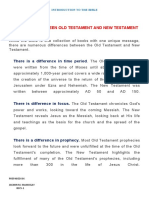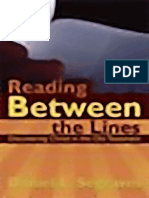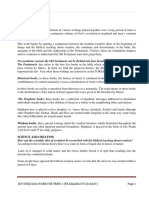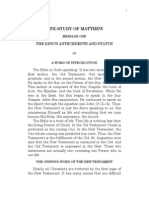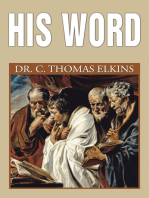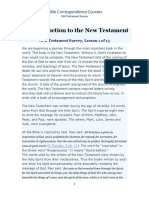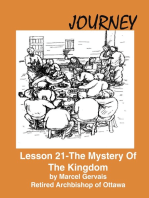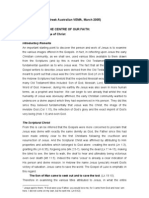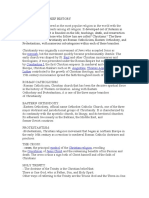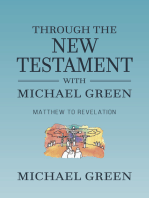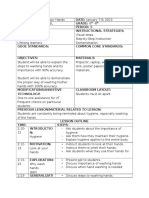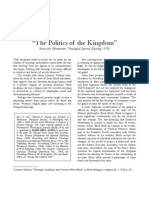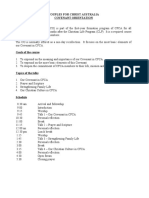Difference Between Old and New Testament
Difference Between Old and New Testament
Uploaded by
cruzleticiaCopyright:
Available Formats
Difference Between Old and New Testament
Difference Between Old and New Testament
Uploaded by
cruzleticiaOriginal Description:
Copyright
Available Formats
Share this document
Did you find this document useful?
Is this content inappropriate?
Copyright:
Available Formats
Difference Between Old and New Testament
Difference Between Old and New Testament
Uploaded by
cruzleticiaCopyright:
Available Formats
What are the differences between
the Old and New Testaments?
While the Bible is one collection of books with one unique
message, there are numerous differences between the Old
Testament and New Testament.
There is a difference in time period. The Old Testament books
were written from the time of Moses until about 400 BC. This approximately 1,000-year period covers a wide
range of events from the creation of the universe to the return of the Jewish people to Jerusalem under Ezra and
Nehemiah. The New Testament was written between approximately AD 50 and AD 150.
There is difference in focus. The Old Testament chronicles God's power and works, looking toward the coming
Messiah. The New Testament reveals Jesus as the Messiah, looking back at His life and teachings as the basis
for the church and the spread of the gospel.
There is a difference in prophecy. Most Old Testament prophecies look forward to the future and were
unfulfilled at the time of the Old Testament's completion. The New Testament highlights the fulfillment of
many of the Old Testament's prophecies, including more than 300 in the life of Jesus Christ.
There is a difference in the practice of worship. Much of the Old Testament focused on the tabernacle or temple
as the central place of worship. Many details were included in the development of offerings, festivals, and
related practices. In the New Testament, Jesus offered Himself as the focus of worship, claiming to be the way,
the truth, and the life, and that no one could come to the Father except through Him (John 14:6).
There is a difference in the covenant. The Old Testament emphasized the Mosaic covenant with its focus on the
Law of the Lord. The New Testament began a new covenant in which Jesus came as a fulfillment of the Law.
No longer would the Jewish people (or Gentiles) need to fulfill the Law to find atonement; Jesus offered
forgiveness and eternal life to all who believed in Him.
There is also a difference in size. The Old Testament includes thirty-nine of the Bible's sixty-six books and
makes up about three-fourths of the entire Bible. The New Testament includes twenty-seven books, including
four Gospels, one book of history (Acts), twenty-one letters, and one book of prophecy (Revelation).
In many ways the Old Testament serves as the foundation for
the New Testament. While the Old Testament comprises
approximately three-fourths of the Bible, its contents point
toward the Messiah who is revealed in the New Testament.
Rather than an entirely new message, the New Testament
reveals how Jesus fulfilled the predictions regarding the
Messiah and provides many of His teachings and miracles,
along with the writings of His earliest followers.
Copyright 2011-2019 Got Questions Ministries - All Rights Reserved.
You might also like
- The Seven Gifts of The Holy SpiritDocument2 pagesThe Seven Gifts of The Holy Spiritcruzleticia67% (3)
- Success in Marriage by OyedepoDocument117 pagesSuccess in Marriage by OyedepoBusola Bamidele100% (1)
- Facts of The BibleDocument19 pagesFacts of The Biblesmithyjohn13100% (4)
- Instrumental MusicDocument160 pagesInstrumental Musicdangutm0% (1)
- Abrahamic Covenant ChartDocument7 pagesAbrahamic Covenant Chartdano521No ratings yet
- Difference Between Old Testaments and New TestamentDocument3 pagesDifference Between Old Testaments and New TestamentBarangay DitumaboNo ratings yet
- Reading Between The Lines Discovering Christ in The Old Testament (Daniel L Segraves) (Z-Library)Document201 pagesReading Between The Lines Discovering Christ in The Old Testament (Daniel L Segraves) (Z-Library)javier andres gonzalez cortesNo ratings yet
- Jesus' Teachings, As Told in The Gospels: A Summary of The Teachings of Jesus During His Three Years of Earthly MinistryDocument78 pagesJesus' Teachings, As Told in The Gospels: A Summary of The Teachings of Jesus During His Three Years of Earthly MinistrySriramNo ratings yet
- Class Xii TextbookDocument34 pagesClass Xii Textbookreubenraju3953No ratings yet
- Meaning and Writing of GospelsDocument5 pagesMeaning and Writing of GospelsKevin TooNo ratings yet
- Module 5 - CleDocument8 pagesModule 5 - CleAte Gay OfficialsNo ratings yet
- The GospelsDocument12 pagesThe Gospelssanjayrajanand18No ratings yet
- Class XII EnglishDocument60 pagesClass XII Englishmmtrgriksdj100% (1)
- GOD WITH US: The life-changing story of Jesus. New Catholic editionFrom EverandGOD WITH US: The life-changing story of Jesus. New Catholic editionNo ratings yet
- Lesson 4 Jesus in The Gospels 1Document5 pagesLesson 4 Jesus in The Gospels 1Quennie Kate RomeroNo ratings yet
- The Books of The Bible-ModuleDocument38 pagesThe Books of The Bible-Modulejillene catapang67% (3)
- Open Week 7 Lesson A - Jesus of Nazareth-MergedDocument21 pagesOpen Week 7 Lesson A - Jesus of Nazareth-MergedMichaella Purganan100% (1)
- Knowing How The Gospels Were Formed PDFDocument24 pagesKnowing How The Gospels Were Formed PDFKeith Carlo RojasNo ratings yet
- M1 - L4 Jesus in The GospelsDocument17 pagesM1 - L4 Jesus in The GospelsalduscraigNo ratings yet
- Jesus in The GospelsDocument14 pagesJesus in The Gospelsniininikrik1209No ratings yet
- Tracing The Historical Life of JesusDocument35 pagesTracing The Historical Life of JesusDaniel Anthony CabreraNo ratings yet
- Klasik Bati Edebiyati (Vize)Document7 pagesKlasik Bati Edebiyati (Vize)Dilek ZehraNo ratings yet
- The MainDocument19 pagesThe Maingracemariograce1No ratings yet
- g8 Notes On The New Testament and The GospelsDocument6 pagesg8 Notes On The New Testament and The Gospelsapi-257208960No ratings yet
- CS NotesDocument75 pagesCS NotesWilliam StainsNo ratings yet
- TTB - Acts Bible CompanionDocument114 pagesTTB - Acts Bible CompanionLun kipgenNo ratings yet
- Matt 001.1ADocument8 pagesMatt 001.1ASue WetherellNo ratings yet
- Reading Scripture Through The Christ Lens Ubf OrgDocument19 pagesReading Scripture Through The Christ Lens Ubf OrgVineedh MathewNo ratings yet
- Travelling Through the Testaments Volume 2: The New TestamentFrom EverandTravelling Through the Testaments Volume 2: The New TestamentNo ratings yet
- S.5 Work Term One 2024Document91 pagesS.5 Work Term One 2024sts2pf6zv2No ratings yet
- Jesus in The GospelsDocument17 pagesJesus in The GospelsNeri La LunaNo ratings yet
- Background of The Old Testament - AbridgedDocument5 pagesBackground of The Old Testament - AbridgedadabuchiNo ratings yet
- Scipture and TraditionDocument12 pagesScipture and TraditionCustomer ServiceNo ratings yet
- Christology Prelim 2023Document28 pagesChristology Prelim 2023Frankie “KIM” MataNo ratings yet
- MatthewDocument831 pagesMatthewMargaret WaltersNo ratings yet
- Fundamentals of Theology: Angelica M. Amatorio Bs Criminology 1Document3 pagesFundamentals of Theology: Angelica M. Amatorio Bs Criminology 1Jin AmatorioNo ratings yet
- Christian Way of Life Topic 2Document3 pagesChristian Way of Life Topic 2Danielyn GestopaNo ratings yet
- Rose Guide to the Gospels: Side-by-Side Charts and OverviewsFrom EverandRose Guide to the Gospels: Side-by-Side Charts and OverviewsRating: 5 out of 5 stars5/5 (1)
- NT Module 4Document8 pagesNT Module 4rexyNo ratings yet
- Immanuel in Our Place Seeing Christ in Israel's Worship (Gospel According To The Old Testament) (Tremper Longman (Longman, Tremper) ) (Z-Library)Document273 pagesImmanuel in Our Place Seeing Christ in Israel's Worship (Gospel According To The Old Testament) (Tremper Longman (Longman, Tremper) ) (Z-Library)Iber AguilarNo ratings yet
- Baxter Excerpt Chapter1Document7 pagesBaxter Excerpt Chapter1AllenNo ratings yet
- Introduction To The Altar of IncenseDocument7 pagesIntroduction To The Altar of IncenseYannick MayengaNo ratings yet
- The Four GospelsDocument33 pagesThe Four GospelsBermonica Alvior SatuitoNo ratings yet
- 43 Synoptics LukeDocument13 pages43 Synoptics Lukesmithobrady22No ratings yet
- Reviewer EditedDocument5 pagesReviewer EditedshaqNo ratings yet
- BCC 6 New Testament SurveyDocument43 pagesBCC 6 New Testament SurveyIvan RicoNo ratings yet
- Module 4 The GospelsDocument4 pagesModule 4 The GospelsChristina AlmeroNo ratings yet
- 30-Second Bible: The 50 most meaningful moments in the Bible, each explained in half a minuteFrom Everand30-Second Bible: The 50 most meaningful moments in the Bible, each explained in half a minuteRating: 3.5 out of 5 stars3.5/5 (4)
- Matthew The ApostleDocument76 pagesMatthew The ApostleNeil Marjunn Torres100% (1)
- The Church - Prelims - 2nd YearDocument8 pagesThe Church - Prelims - 2nd YearNicole SorongonNo ratings yet
- Matthew - Irving L. JensenDocument132 pagesMatthew - Irving L. Jensengetulio freitasNo ratings yet
- Enduring Treasure: The Lasting Value of the Old Testament for ChristiansFrom EverandEnduring Treasure: The Lasting Value of the Old Testament for ChristiansNo ratings yet
- Scriptule ModuleDocument46 pagesScriptule ModuleCj Mustang12100% (1)
- The Scriptural Image of ChristDocument9 pagesThe Scriptural Image of ChristPhilip KariatlisNo ratings yet
- World Re ReportDocument4 pagesWorld Re ReportSheian MirandaNo ratings yet
- The Bible Syllabus - MatthewDocument27 pagesThe Bible Syllabus - Matthewlogosbiblestudy100% (5)
- Through the New Testament with Michael Green: Matthew to RevelationFrom EverandThrough the New Testament with Michael Green: Matthew to RevelationNo ratings yet
- A Bible Handbook For Beginners: Thy Word is a lamp unto my feet, and a light unto may pathFrom EverandA Bible Handbook For Beginners: Thy Word is a lamp unto my feet, and a light unto may pathNo ratings yet
- Dogmas of MaryDocument6 pagesDogmas of MarycruzleticiaNo ratings yet
- The Purpose of The RosaryDocument1 pageThe Purpose of The RosarycruzleticiaNo ratings yet
- Week #: - NameDocument1 pageWeek #: - NamecruzleticiaNo ratings yet
- Hawaii LessonDocument20 pagesHawaii LessoncruzleticiaNo ratings yet
- Piti Pre-Confirmation Class Syllabus 2019-2020Document3 pagesPiti Pre-Confirmation Class Syllabus 2019-2020cruzleticiaNo ratings yet
- Transition To Post-Secondary LifeDocument8 pagesTransition To Post-Secondary LifecruzleticiaNo ratings yet
- TeamworkDocument14 pagesTeamworkcruzleticiaNo ratings yet
- Leticia Cruz Siguenza: ObjectiveDocument6 pagesLeticia Cruz Siguenza: ObjectivecruzleticiaNo ratings yet
- Family Math Night FlyerDocument1 pageFamily Math Night FlyercruzleticiaNo ratings yet
- Consultation Form: A Copy of This Form May Be Provided To Consulting Parties Upon RequestDocument2 pagesConsultation Form: A Copy of This Form May Be Provided To Consulting Parties Upon RequestcruzleticiaNo ratings yet
- MexicoDocument25 pagesMexicocruzleticiaNo ratings yet
- Consultation LogDocument2 pagesConsultation LogcruzleticiaNo ratings yet
- Formal Assessment LogDocument2 pagesFormal Assessment LogcruzleticiaNo ratings yet
- Activity Grading SheetDocument3 pagesActivity Grading SheetcruzleticiaNo ratings yet
- Colors LPDocument5 pagesColors LPcruzleticiaNo ratings yet
- Para-educator/TA Working ResumeDocument1 pagePara-educator/TA Working ResumecruzleticiaNo ratings yet
- Lesson Plan Primary Special Education Ms. L. CruzDocument4 pagesLesson Plan Primary Special Education Ms. L. CruzcruzleticiaNo ratings yet
- Washing Your Hands LPDocument2 pagesWashing Your Hands LPcruzleticiaNo ratings yet
- Para-Educator: Getting To Know My StudentDocument2 pagesPara-Educator: Getting To Know My StudentcruzleticiaNo ratings yet
- FES Subtracting Single Digit Numbers LPDocument4 pagesFES Subtracting Single Digit Numbers LPcruzleticiaNo ratings yet
- Context Clues LPDocument4 pagesContext Clues LPcruzleticiaNo ratings yet
- FES Sight Word Identification LPDocument3 pagesFES Sight Word Identification LPcruzleticiaNo ratings yet
- Old Testament Vs New TestamentDocument9 pagesOld Testament Vs New TestamentcsummNo ratings yet
- The Anatomy of Exposition:: Logos, Ethos, and PathosDocument15 pagesThe Anatomy of Exposition:: Logos, Ethos, and PathosJohn LukezicNo ratings yet
- Healing Belongs To Us Supernatural Sunday Ps Ashish RaichurDocument11 pagesHealing Belongs To Us Supernatural Sunday Ps Ashish RaichurapcwoNo ratings yet
- Handout 1: Exodus Lesson 2: Typology of Moses and JesusDocument4 pagesHandout 1: Exodus Lesson 2: Typology of Moses and Jesusdpate117No ratings yet
- Christian Morality-Historical DevelopmentDocument50 pagesChristian Morality-Historical DevelopmentVj McNo ratings yet
- Kate McVeigh The Blessing of Favor Experiencing Gods Supernatural Influence 2003 PDFDocument144 pagesKate McVeigh The Blessing of Favor Experiencing Gods Supernatural Influence 2003 PDFenoch_boateng100% (1)
- Unbreakable PromiseDocument40 pagesUnbreakable PromisePastor Eliseu AlvesNo ratings yet
- ARISE Online 12 Month Study PlanDocument1 pageARISE Online 12 Month Study PlanWinner SilvestreNo ratings yet
- Biblical Worship Is Good For YouDocument9 pagesBiblical Worship Is Good For YouEsther Renda ItaarNo ratings yet
- 2 Corinthians GreekDocument3 pages2 Corinthians GreekTeresaVrazelKiehlNo ratings yet
- Stirring Up The Holy SpiritDocument25 pagesStirring Up The Holy Spiritabcdef79No ratings yet
- Clowney - Politics of The KingdomDocument11 pagesClowney - Politics of The Kingdomslin_46No ratings yet
- Term PaperDocument27 pagesTerm PaperTabbitha RichardsonNo ratings yet
- Kenneth E Hagin - Leaflet - Mountain Moving Faith ForgivesDocument4 pagesKenneth E Hagin - Leaflet - Mountain Moving Faith ForgivesAnselm MorkaNo ratings yet
- CFCA PFO Talk Review - Covenant Orientation - 30 June 2020Document38 pagesCFCA PFO Talk Review - Covenant Orientation - 30 June 2020Cris AsuncionNo ratings yet
- Philippians CompleteDocument67 pagesPhilippians Completetaylor12_1100% (2)
- Are Adventists Old-Covenant Christians? (Part 3) : "Dispensationalism & New Covenant Theology"Document10 pagesAre Adventists Old-Covenant Christians? (Part 3) : "Dispensationalism & New Covenant Theology"Weverson PresenzaNo ratings yet
- Mirrors Sermon 2-10-2013Document5 pagesMirrors Sermon 2-10-2013session3996No ratings yet
- Topic 5 - The Commandments - Our Blueprint For Moral LifeDocument14 pagesTopic 5 - The Commandments - Our Blueprint For Moral LifeEdeodito BatilesNo ratings yet
- Transcript Talk 1 John Piper at Lausanne 2010 Cape TownDocument18 pagesTranscript Talk 1 John Piper at Lausanne 2010 Cape TownMark DicksonNo ratings yet
- Huiothesia Lsms Attack On AdoptionDocument23 pagesHuiothesia Lsms Attack On AdoptionelencticusNo ratings yet
- Messianic Siddur BookletDocument38 pagesMessianic Siddur BookletNANI VMK50% (2)
- The Laws of HealingDocument24 pagesThe Laws of HealingElango GopalNo ratings yet
- Dictionary of Christ and The Gospels, Vol. I:373-380. (1906)Document16 pagesDictionary of Christ and The Gospels, Vol. I:373-380. (1906)Juan Carlos HerreraNo ratings yet
- Christ, Our Great ProphetDocument8 pagesChrist, Our Great ProphetGrace Church ModestoNo ratings yet
- Eat, Sleep, Prophesy, Repeat -- Tomi Arayomi -- 1st, 2018 -- Tomi Arayomi Ministries -- 9780244134297 -- c282902e5bbecf4c49dd17c9627a4cd5 -- Anna’s ArchiveDocument325 pagesEat, Sleep, Prophesy, Repeat -- Tomi Arayomi -- 1st, 2018 -- Tomi Arayomi Ministries -- 9780244134297 -- c282902e5bbecf4c49dd17c9627a4cd5 -- Anna’s Archivemathew creation100% (1)
- Adult STS Lesson 54 - Moses Receives The Law at Mount SinaiDocument3 pagesAdult STS Lesson 54 - Moses Receives The Law at Mount SinaiIt's In The SpiritNo ratings yet





